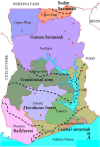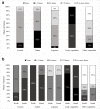Home-grown school feeding: promoting local production systems diversification through nutrition sensitive agriculture
- PMID: 33365103
- PMCID: PMC7705133
- DOI: 10.1007/s12571-017-0760-5
Home-grown school feeding: promoting local production systems diversification through nutrition sensitive agriculture
Abstract
The consumption of some non-staple crops such as legumes and dark, green leafy vegetables can address common deficiencies in key nutrients such as vitamin A and iron; however, limited markets and supply chain development impede their production and accessibility to consumers. This study investigates the pathways to promote agricultural production and dietary diversity for a local market intervention called Home-Grown School Feeding (HGSF). School feeding menus from 24 districts across 10 regions in Ghana during the 2014-15 school year were analysed in terms of food groups and several individual foods. The menus were then compared with food groups produced by households during the past year or consumed in the past seven days using data collected from a household survey. Greater inter-food group diversity in the menus was associated with higher production levels for tubers and dark, leafy green vegetables in the South and cereals in the North. A correspondence between the frequency in which a food group appeared in a menu and the share of households who consumed foods from the food group was also noted. Key issues, such as optimizing supply chains, enabling farm linkages and supporting diverse nutrient rich food groups, that underlie the success of Home-Grown School Feeding and other agricultural policies with similar goals of promoting production and dietary diversity are highlighted through commodity specific examples. The findings of this study may help strengthen operational linkages between agriculture production and nutrition for HGSF and other similar interventions.
Keywords: Dietary diversity; Policy approaches; Production diversity; Structured demand; Sub-Saharan Africa; Sustainable food systems.
© The Author(s) 2018.
Conflict of interest statement
This work was financially supported by the Bill and Melinda Gates Foundation. The authors report no conflicts of interest.
Figures




Similar articles
-
Farming and the geography of nutrient production for human use: a transdisciplinary analysis.Lancet Planet Health. 2017 Apr;1(1):e33-e42. doi: 10.1016/S2542-5196(17)30007-4. Lancet Planet Health. 2017. PMID: 28670647 Free PMC article.
-
Considerations for the design of nutrition-sensitive production programmes in rural South Africa.BMC Public Health. 2020 Sep 10;20(1):1383. doi: 10.1186/s12889-020-09445-3. BMC Public Health. 2020. PMID: 32912223 Free PMC article.
-
Enhancing Linkages Between Healthy Diets, Local Agriculture, and Sustainable Food Systems: The School Meals Planner Package in Ghana.Food Nutr Bull. 2016 Dec;37(4):571-584. doi: 10.1177/0379572116659156. Epub 2016 Jul 19. Food Nutr Bull. 2016. PMID: 27435223
-
Incorporating orange-fleshed sweet potato into the food system as a strategy for improved nutrition: The context of South Africa.Food Res Int. 2018 Feb;104:77-85. doi: 10.1016/j.foodres.2017.09.016. Epub 2017 Sep 9. Food Res Int. 2018. PMID: 29433786 Review.
-
Locally-Procured Fish Is Essential in School Feeding Programmes in Sub-Saharan Africa.Foods. 2021 Sep 2;10(9):2080. doi: 10.3390/foods10092080. Foods. 2021. PMID: 34574190 Free PMC article. Review.
Cited by
-
Impact of Homegrown School Feeding Program on Smallholders' Farmer Household Food Security in Northeastern Nigeria.Foods. 2023 Jun 18;12(12):2408. doi: 10.3390/foods12122408. Foods. 2023. PMID: 37372619 Free PMC article.
-
Home-Grown School Feeding: Implementation Lessons From a Pilot in a Poor Ethnic Minority Community in Vietnam.Food Nutr Bull. 2022 Sep;43(3):271-302. doi: 10.1177/03795721221088962. Epub 2022 Apr 26. Food Nutr Bull. 2022. PMID: 35470722 Free PMC article.
-
Learning in times of lockdown: how Covid-19 is affecting education and food security in India.Food Secur. 2020;12(4):793-796. doi: 10.1007/s12571-020-01065-4. Epub 2020 Jul 7. Food Secur. 2020. PMID: 32837637 Free PMC article.
-
The Exploitation of Orphan Legumes for Food, Income, and Nutrition Security in Sub-Saharan Africa.Front Plant Sci. 2022 May 17;13:782140. doi: 10.3389/fpls.2022.782140. eCollection 2022. Front Plant Sci. 2022. PMID: 35665143 Free PMC article. Review.
-
Investing in school systems: conceptualising returns on investment across the health, education and social protection sectors.BMJ Glob Health. 2023 Dec 18;8(12):e012545. doi: 10.1136/bmjgh-2023-012545. BMJ Glob Health. 2023. PMID: 38114237 Free PMC article.
References
-
- Affognon H., Mutungi C., Sanginga P., & Borgemeister C. (2015). Unpacking postharvest losses in sub-Saharan Africa: a meta-analysis. World Development, 66, 49–68.
-
- Angelucci F., Bazzucchi A., (2013) Analysis of incentives and disincentives for groundnuts in Ghana Technical notes series, MAFAP, FAO: Rome.
-
- Awo M. (2012). Marketing and market queens: A study of tomato farmers in the upper east region of Ghana. LIT: Munich.
-
- Banerjee K. (2011). Decentralized procurement and universalized PDS. EPW, xlvi(52), 19–22.
-
- Barett C. (2008). Smallholder market participation: Concepts and evidence from eastern and southern Africa. Food Policy, 33, 299–317.
LinkOut - more resources
Full Text Sources
Miscellaneous
